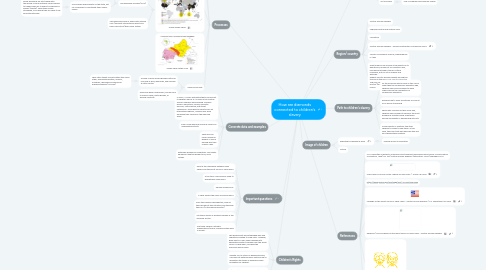
1. Processes
1.1. Movement and Displacement
1.1.1. Movement of families from their villages to makeshift camps closer to the mines
1.1.1.1. ...which can also lead to more infectious diseases, such as vulnerability to malaria and contracting parasites, from drinking the water nearby
1.2. Health Issues
1.2.1. Examples: hernias, exhaustion, injuries, collapsed pit walls
1.2.2. Children work under harmful conditions: transporting and washing gravel, digging pits, using sieves, and carrying heavy loads
1.3. Global supply chain
1.3.1. The Kimberley Process (2012)
1.3.1.1. Banned the export of diamonds from CAR
1.3.1.2. Only places responsibility on the state, not on companies to investigate their supply chains
1.3.1.2.1. Blood diamonds are still traded with thousands of small artisanal miners selling to traders who sell to export companies in Bangui (capital). There they remain stockpiled, from which they are likely to be sold internationally.
1.3.2. The diamonds arrive in Dubai after leaving CAR (Amnesty International report and Daily Mail article) then move further
1.4. Supply chain within CAR
1.5. Violence and War
1.5.1. Around a dozen armed groups battle for land rich in gold, diamonds, and uranium & cattle routes
1.5.1.1. They often target civilians rather than each other, and health facilities, schools, mosques, churches and camps for displaced people (UNICEF)
1.5.2. Diamonds have funded wars, and are sold to finance rebel, militia groups, or warlord's activity
2. Concrete data and examples
2.1. In 2000, UNICEF estimated that 63.5 percent of children ages 5 to 14 years in the Central African Republic were working. Children work in agriculture, mining, domestic services, cattle raising, and street vending.727 According to reports from an international agency, children also work alongside their families in the diamond fields.
2.2. small-scale diamond mining is usually an unregulated activity
2.3. There are one million diamond diggers in Africa earning less than a dollar a day.
2.4. extremely dangerous conditions: lack safety equipment and the proper tools, mine collaps
3. Important questions
3.1. What is the difference between child slavery and the worst forms of child labor?
3.2. Is the term "child slavery" used to delegitimize child labor?
3.3. Gender differences?
3.4. Is child slavery the same as forced labor?
3.5. From the children's perspective, how do they feel about their situation and the work they do? (in the diamond sector)
3.6. Are there unions of working children in the diamond sector?
3.7. Are there children-initiated organisations/unions concerning the work in mines?
4. Children’s Rights
4.1. The government has established laws and regulations related to child labor. However, gaps exist in CAR's legal framework to adequately protect children from the worst forms of child labor, including the minimum age for work.
4.2. Despite a 2016 study on hazardous work, CAR has not determined by national law or regulation the types of hazardous work prohibited for children.
4.3. Although the Labor Code prohibits work by children under age 14, the law does not apply to children outside of formal employment relationships, which does not conform to international standards that require all children be protected under the law establishing a minimum age for work.
5. Region/ country
5.1. Central African Republic
5.2. ongoing political and military crisis
5.3. corruption
5.4. Central African Republic - General Distribution of Diamond Mines
5.5. Former colonised by France, independence in 1960
5.6. What makes CAR unusual is the quality of its gemstones, prized not for industrial uses, like diamond-tipped, tunnel-cutting machines, but for use in jewelry and watches. Experts rank its diamond quality among the top five in the world. The country exported 378,000 carats of diamond in 2012, worth around $167.05 per carat, about $63 million.
6. Group of children
6.1. Children living in the streets
6.2. Children whose parents died (due to HIV/ AIDS)
6.3. out of school
6.3.1. 42% of children finish primary school
7. Path to children‘s slavery
7.1. As the minimum age for work in the CAR is lower than the compulsory education age, children may be encouraged to leave school before the completion of compulsory education.
7.2. being forced to work sometimes as a result of of human trafficking
7.3. Physicality: because of their small size, children may be asked to perform the most dangerous activities such as entering narrow mineshafts or descending into pits
7.4. Some parents or relatives take their children to mines to help them. In this case, they don’t get paid because they are only helping their relatives.
8. Image of children
8.1. exploited by hazardous work
8.1.1. lacking access to education

